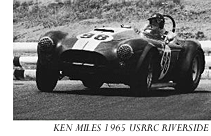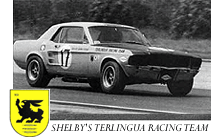KEN MILES, an appreciation
continued ...
 The next large step came in Ken's career when he went to work for Carroll Shelby. He drove for Shelby before going to work for him full time but it was after Ken became closely associated with Shelby America that his greatest national and international fame was acheived. No one who followed the first two seasons of U.S. Road Racing Championship racing can forget Ken in the factory Cobra. It was through Shelby America and the Cobra campaigns that the rest of the U.S. was exposed to both Ken's driving and his personality. And that experience enriched both of them, I think.
The next large step came in Ken's career when he went to work for Carroll Shelby. He drove for Shelby before going to work for him full time but it was after Ken became closely associated with Shelby America that his greatest national and international fame was acheived. No one who followed the first two seasons of U.S. Road Racing Championship racing can forget Ken in the factory Cobra. It was through Shelby America and the Cobra campaigns that the rest of the U.S. was exposed to both Ken's driving and his personality. And that experience enriched both of them, I think.
His last season, of course, was the season of his greatness with victories at the Daytona 24-hr race, the Sebring 12-hr and except-for-a-fluke, the Le Mans 24-hr race. For these things alone, Ken's name will be remembered, for his driving earned it.
Yet his racing record, even if it were to include every race he ever ran, couldn't do more than hint at what Ken Miles was like or what he meant to the sport. Nor have the biographical sketches. Nor the uniformly respectful obituaries that have appeared since his death.
No amount of cold factual information can convey how much Ken meant to the formative years of road racing in Southern California, for example. When I discovered road racing, Ken was president of the California Sports Car Club and winning consistently in his first MG Special. He was not only the hero driver of the day, he also ran the club that staged the race. And furthermore he built the car in which he won the under-1500-cc race (which were an hour long in those days) and, in all likelihood, finished no worse than third or fourth in the over-1500-cc race. To so many of us, he was road racing in those days.
 Ken represented what road racing was all about. It was not only courage, which we had seen before in the traditional round-track racing, but it was also coolness, skill, finesse. Anybody could go fast on the straight --- if he could afford the car that would do it --- but it was Ken who showed us about going deeper into corners, who shifted down with immense skill and who would probably continue to smile as he passed an adversary on the inside. He had style and we loved it.
Ken represented what road racing was all about. It was not only courage, which we had seen before in the traditional round-track racing, but it was also coolness, skill, finesse. Anybody could go fast on the straight --- if he could afford the car that would do it --- but it was Ken who showed us about going deeper into corners, who shifted down with immense skill and who would probably continue to smile as he passed an adversary on the inside. He had style and we loved it.
He exemplified road racing to us, the idol who reflected everything that was new and intriquing about the sport. The first quick-lift jack I ever saw was used on his Flying Shingle during the over-1500-cc main event at Palm Springs. Quick-lift jacks are nothing at all to me anymore but that first one (one motion and the rear of the car was up in the air and a pit crew member was whacking a hub spinner off a wire wheel), entering into a consciousness that he'd never previously known anything more glamorous than a garden-variety floor jack, was something pretty special.
And Ken knew about the organization of racing too. He was the Cal Club and when he ran it, he ran it from a driver's point of view and for the driver's benefit. So he was not only a driver who could build a winning car, he also knew how to set up a circuit, how to arrange a starting grid and what the procedure should be for scrutineering.
In other words, we believed Ken Miles knew everything that needed to be known about road racing and we were properly respectful because we barely knew an SU from an Amal and a Weber was only something we'd read about in Road & Track.
He talked and we listened and we learned. We watched and we admired. And his British accent, even if slightly incomprehensible as it came out the side of his mouth, seemed exactly right.
Yes, we discovered Ken Miles when we discovered the marvelous new world of road racing and his name became part of our conversation along with such things as shut-off-points, Mowog and heel-and-toe. His death is all the more poignant because it severs a link with that period of wonder and excitement.
 *
*
 The next large step came in Ken's career when he went to work for Carroll Shelby. He drove for Shelby before going to work for him full time but it was after Ken became closely associated with Shelby America that his greatest national and international fame was acheived. No one who followed the first two seasons of U.S. Road Racing Championship racing can forget Ken in the factory Cobra. It was through Shelby America and the Cobra campaigns that the rest of the U.S. was exposed to both Ken's driving and his personality. And that experience enriched both of them, I think.
The next large step came in Ken's career when he went to work for Carroll Shelby. He drove for Shelby before going to work for him full time but it was after Ken became closely associated with Shelby America that his greatest national and international fame was acheived. No one who followed the first two seasons of U.S. Road Racing Championship racing can forget Ken in the factory Cobra. It was through Shelby America and the Cobra campaigns that the rest of the U.S. was exposed to both Ken's driving and his personality. And that experience enriched both of them, I think. Ken represented what road racing was all about. It was not only courage, which we had seen before in the traditional round-track racing, but it was also coolness, skill, finesse. Anybody could go fast on the straight --- if he could afford the car that would do it --- but it was Ken who showed us about going deeper into corners, who shifted down with immense skill and who would probably continue to smile as he passed an adversary on the inside. He had style and we loved it.
Ken represented what road racing was all about. It was not only courage, which we had seen before in the traditional round-track racing, but it was also coolness, skill, finesse. Anybody could go fast on the straight --- if he could afford the car that would do it --- but it was Ken who showed us about going deeper into corners, who shifted down with immense skill and who would probably continue to smile as he passed an adversary on the inside. He had style and we loved it.